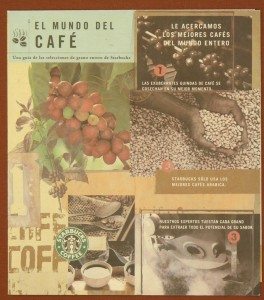 This is the second of three blog entries where we briefly take StarbucksMelody to international places. This episode is Mexico. Again, there will be no in-depth analysis here, just dipping the big toe into the shallow end of the pool. This beautiful coffee menu comes from a friend who took a vacation to Mexico about one year ago. Notice that the whole bean coffee offerings offer a true variety and far more decaf options than what is available in North America. Really, I’m writing this blog entry to share with all of you this cool menu from Mexico.
This is the second of three blog entries where we briefly take StarbucksMelody to international places. This episode is Mexico. Again, there will be no in-depth analysis here, just dipping the big toe into the shallow end of the pool. This beautiful coffee menu comes from a friend who took a vacation to Mexico about one year ago. Notice that the whole bean coffee offerings offer a true variety and far more decaf options than what is available in North America. Really, I’m writing this blog entry to share with all of you this cool menu from Mexico.
As for a little background on the Mexico Starbucks market: Starbucks has operated continuously in Mexico since September 2002. Usually I can find some sort of Starbucks newsroom press release giving precise information about the history of the entry into a new market but in this case, I couldn’t find any such press-release. One online news source cited the entry date as September 5, 2002, and another one cited September 7, 2002. I am certain though that the first Starbucks, in the heart of Mexico City, represents Starbucks first foray into Latin America.
Despite that Starbucks has only operated coffeehouses in Mexico for less than a decade, this country has held a special significance for Starbucks for their work that has been done in partnership with Conservation International and especially in the Chiapas region of Mexico:
The Conservation International website tells of the following history with Starbucks, dating back to 1998:
Starbucks was quick to see the importance of protecting El Triunfo and similar areas worldwide that bordered prized coffee-growing farms. Together, we launched a three-year program encouraging coffee growers in Chiapas to continue their sustainable farming practices. In return, they received technical assistance from CI’s field staff and Starbucks became a dependable buyer of the farmers’ beans.
That initial collaboration quickly proved successful. Within a year, the number of farmers taking part in the Chiapas project increased by 30 percent. Some of them doubled their sales, and their average incomes jumped by 40 percent. At the same time, U.S. consumers enthusiastically embraced a new Starbucks brand: Shade Grown Mexico.
The first of the three “Around the Globe” episodes on StarbucksMelody was Japan. Click here for the Japan episode.
And if you enjoyed this Mexico episode, you may also like the following:
Related posts
11 Comments
Leave a Reply Cancel reply
You must be logged in to post a comment.
Sponsors
Recent Comments
- DEVIN on Compostable Straws Land in Seattle Starbucks Stores
- coffeebeanz on Why do you go to Starbucks less often? (If that’s true for you)
- Willi on You can now buy a Siren statue: $6,000
- Willi on A major revamp of your drink recipe: Testing syrup extracts and cane sugar
- Skip on Why do you go to Starbucks less often? (If that’s true for you)




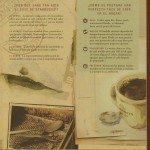

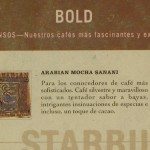
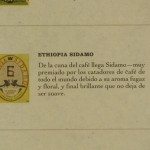
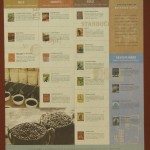
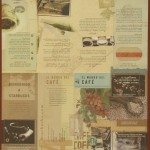



Your article is excellent.
I was able to learn it about Conservation International.
thank you Melody!
Talking of Conservation International, I am excited at that.
Eco-conscious Starbucks Card!!
Beautiful menu from Mexico.
what a gorgeous menu
Love it!!!
Hi all! Thanks for the comments! Does anyone know if Mexico really sells that wide variety of coffees featured on the menu. I haven’t seen an Arabian Mocha Java inside a U.S. Starbucks in a long long time. Is that offering of coffees even remotely current? And notice that their decaf selection is different from the US too…
Good article! Thanks for the link to Conservation International.
While I don’t know if Mexico really sells that variety of coffees, I wouldn’t be surprised. I hear Arabian Mocha Sanani is still available in the UK, whereas we haven’t had it for a while. I also see Sulawesi on that menu, which we also haven’t had for some time. For some reason, we don’t sell anywhere near the variety of coffees in our US Starbucks as they seem to elsewhere – elsewhere including grocery stores.
Seriously! I went to the grocery store and checked out the coffee isle and saw all sorts of Starbucks blends that we don’t sell in the Starbucks around here – Africa Kitamu, Costa Rica Tarrazu, Daily Horizons Blend. I don’t understand that. Why sell them at Krogers and Bi-Lo and Piggly Wiggly and not in the actual Starbucks stores?
But I digress; back to your pretty Mexican menu. I found it kinda interesting how they group up the coffees – Mild, Smooth, and Bold. Not by region; nor do they even do it by Mild, Medium, Bold, and Extra-Bold (check out the “Smooth” category; it has some coffees, like Espresso Roast and Yukon, that are bolder than some of the “Bold” picks). I suppose it’s not a bad way to organize them, though.
I also like how they go over coffee fundamentals in the menu. That’s pretty cool.
Anyways, great find!
Love this. Love that you are basically creating a library of Starbucks knowledge with each new post. The Ethiopia Sidamo stamp looks really cool!
Also, I’ve never even tried Arabian Mocha Java. Does anyone remember what it tasted like? Was it similar to Arabian Mocha Sanani? What’s the difference?
@ECSage I can’t speak for 2 of the 3 coffees you listed, but the Africa Kitamu blend is one of my absolute favorite of Starbucks coffees! It is wonderful, if you haven’t tried it.
I’m thinking that I will enjoy the (Red) coffee when the bold journey starts in stores next week. My local store never had it as a featured COW so I haven’t tried it yet, but it has similar notes to the Africa Kitamu (not surprising obviously since they are both African origin).
(Red) is a coffee that kinda baffles me. I don’t know how it’s processed, but I suspect it may be dry processed because every time I do a tasting, the flavor changes. (Or perhaps the “brown spice” flavor notes in it is melange, and if I drink enough of it my eyes will turn all blue and I’ll see the future. The spice must flow!)
The first time I tried it, it blew me away. I thought it was probably the best coffee I ever had, and certainly the most unique. The second time I tried it, it left me kinda cold. The third time I tried it, I thought it was OK.
It does have a very unique flavor profile; no other coffee I’ve tried tastes quite like it. It has a sort of brown sugar-y taste (without being sweet), along with fruity and herbal notes.
Great to see someone giving props to Starbucks and the effort they have put forth in areas like Fair Trade. My wife was a Black Apron Barista and I can truly appreciate the effort put forth in your blogging.